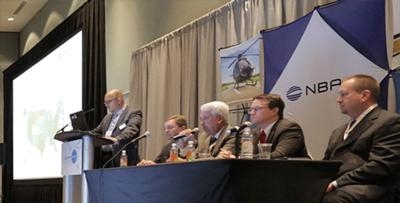Panel Explores This Newest Segment Of The Industry At NBAA-BACE
While the recently enacted Part 107 rule clarified many issues regarding commercial operation of small unmanned aircraft systems (sUAS), demands from operators seeking to utilize a wide variety of UAS in their businesses continues to outpace the emerging regulatory framework. The session titled "Evolution of UAS: A Regulatory and Application Perspective” sought to answer some of these questions at NBAA-BACE.

Panelist Jay Merkle, FAA director for program control and integration, noted that more than 8,200 remote pilot tests have been conducted since Part 107 became effective on Aug. 29, with 19,000 operator and 1,500 airspace applications received.
“This isn’t about thinking [about implementation] anymore," he continued. "Part 107 is here, and people are operating under it. It's arrived, and we're doing it." The pace of remote pilot approvals should quicken by next summer, he added, when the FAA automates the authorizations process through a web-based resource.
Panelists also addressed how the rule has affected other UAS authorization routes, including issuance of certificates of authorization and exemptions under Section 333 of the FAA Modernization and Reform Act of 2012. Both methods remain in effect for proposed UAS operations falling outside the scope of Part 107, including UAS weighing more than 55 lbs., beyond line-of-sight operations, or carrying hazardous materials.
"You'll need to fall back on another mechanism" than Part 107 for those approvals, said aviation attorney Jonathan Rupperecht, "but it is workable. Because of that, the culture of the industry is starting to shift towards being a lot more compliant."
Lessons learned through the development of Part 107 also simplified the approvals process for manufacturers and users outside the law’s purview, according to Paul McDuffie, vice president of government relations at Insitu.
"The areas that must be considered [for UAS authorization outside Part 107 requirements] are not unlike those for a business aircraft manufacturer seeking certification,” he explained. "Further, the FAA was really ready to engage with us. We began the process of earning certification for the ScanEagle in December 2012. By July 2013, we achieved that with four aircraft approved for commercial operations under the restricted category."
Who Controls the Airspace?
Attendees also expressed concern over disputes between the FAA, which governs use of the National Airspace System, and state and local municipalities enacting their own laws to restrict UAS operations. Merkle reiterated that the FAA has final say over UAS operations.
"Through 2016, 48 states have attempted some kind of bill or regulation concerning UAS, 280 bills,” Merkle explained, adding that less than 10 percent passed. Of the bills that failed to be enacted, a lot of those bills sought some kind of power to regulate the airspace, [and] a lot of those bills died on the vine.”
"The question also came up, can you actually shoot down a UAS, and is that a criminal violation?" he continued. "We had to contact the Justice Department for the answer." (Per 18 USC 32, it is a federal crime to shoot down any aircraft, even an unmanned one, due to concerns of damage to other persons and property.)
As these technicalities are ironed out, the scope of applications for UAS operations continues to grow, sometime in rather unusual directions. Tom McMahon, vice president for advocacy and public relations at the Association for Unmanned Vehicle Systems International, shared the most unusual UAS mission request he’s seen so far: a drone operating off the Massachusetts coast to capture and analyze whales' breath.
"Sounds fishy, but it's true," he quipped.
The session was moderated by Brian Terwilliger, program chair for masters in science in unmanned systems at Embry-Riddle Aeronautical University and chairman of the UAS subcommittee of NBAA's Business Aviation Management Committee.
(Image provided with NBAA news release)
 Airborne-Flight Training 05.09.24: ERAU at AIAA, LIFT Diamond Buy, Epic A&P
Airborne-Flight Training 05.09.24: ERAU at AIAA, LIFT Diamond Buy, Epic A&P ANN's Daily Aero-Term (05.07.24): Hazardous Weather Information
ANN's Daily Aero-Term (05.07.24): Hazardous Weather Information Aero-News: Quote of the Day (05.07.24)
Aero-News: Quote of the Day (05.07.24) NTSB Final Report: Cessna 150
NTSB Final Report: Cessna 150 Aero-News: Quote of the Day (05.08.24)
Aero-News: Quote of the Day (05.08.24)



